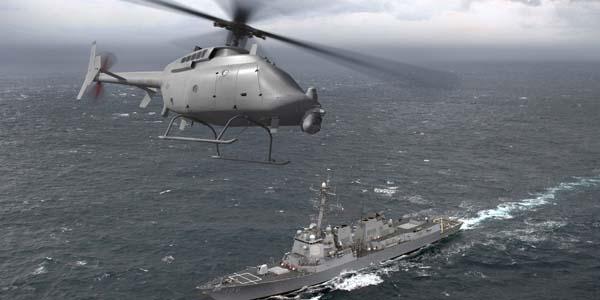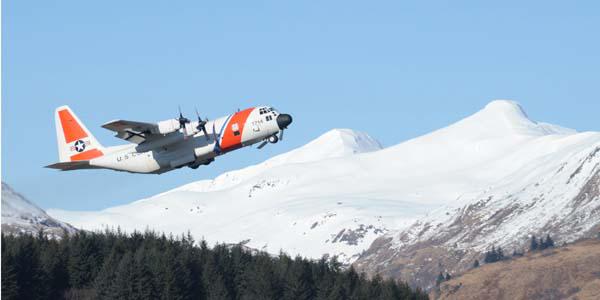U.S. Coast Guard Modernizing Airborne Reconnaissance Fleet
The U.S. Coast Guard is engaged in a major overhaul of airborne reconnaissance capabilities. Ultimately, the various aviation reconnaissance programs will allow the service to shed aging platforms, add unmanned systems, enhance interoperability, improve efficiency and perform its missions more effectively.
The Coast Guard is adding three types of manned, fixed-wing aircraft to its overall reconnaissance fleet—the HC-130J long-range surveillance aircraft and the HC-144A and C-27J, both of which are medium-range reconnaissance platforms. The service also is investigating the possibility of adding small unmanned aerial systems (UASs) in the short term and larger UASs over the long term.
“We’re improving capabilities, no question,” says Scott Rettie, deputy project manager within the Coast Guard’s Aviation Acquisition Office. “Our goal is to have a recapitalized fleet of aircraft that will take us another 30 years.”
The HC-130 provides both tactical airlift and maritime surveillance capabilities and has proven instrumental in natural disasters such as Hurricane Katrina or the 2010 Haiti earthquake. The interim fleet actually consists of two similar but different aircraft, the HC-130H Hercules and the HC-130J Super Hercules. Ultimately, service officials intend to field a fleet made up entirely of the Super Hercules version. “Our end-state program for long-range surveillance aircraft is to have 22 of them, and they will eventually all be HC-130Js,” Rettie explains. “Those aircraft are different enough that we don’t mix them at operating locations.”
The platforms are similar, but differences include propulsion systems, flight decks, cockpits and technology architectures. “The HC-130H is really less of a mission system per se and more of a surveillance platform. They’re similar capabilities, different architectures,” Rettie elaborates. Currently, the Coast Guard has six HC-130Js, with three on contract and another two authorized.
The platforms under contract should begin delivery early this calendar year and will be modified to the HC-130J configuration. “It’s actually a little ahead of schedule. Three more airplanes to a six-aircraft fleet is 50 percent growth. That’s big for us,” Rettie points out. “These aircraft are going to allow us to retire some airframes. Acquiring new airframes provides a means of keeping our fleet fresh and being able to fully task the fleet with all missions without aging aircraft maintenance issues and flight restrictions.”
The HC-130 fleet is complemented with 18 HC-144A Ocean Sentries and ultimately will be enhanced by 14 C-27Js. Ocean Sentries carry out a wide range of Coast Guard surveillance, search and rescue, and transport missions. They can be outfitted with a roll-on, roll-off suite of electronic equipment that enables the aircrew to compile data from the aircraft’s multiple integrated sensors and to transmit and receive both classified and unclassified information from other aircraft, surface vessels and shore facilities.
With multiple voice and data communications and satellite communications, the HC-144A provides a networked command and control system, common tactical picture and common operating picture. The aircraft also is equipped with a vessel automatic identification system, direction-finding equipment, an electro-optical/infrared system and a multimode search radar to improve the Ocean Sentry’s situational awareness and responsiveness.
The HC-144As replaced an aging fleet of HU-25 Falcon jets, the last of which was retired in September 2014. “That was a big milestone for us. That was a complete transition to a new multimission, multicapability aircraft that doesn’t have a Defense Department variant,” Rettie says.
Meanwhile, the Coast Guard is receiving from the Air Force 14 C-27J aircraft that are being adapted to the Coast Guard’s maritime mission. The planes are being transferred under the direction of the 2014 National Defense Authorization Act. The first was delivered in November. As originally delivered, the C-27Js are outfitted with weather radar and communications equipment capable of supporting transport and other Coast Guard missions. Future modifications will include specialized components, such as surface search radar and electro-optical/infrared sensors.
“The aircraft were already in the boneyard out there in the desert, placed there by the Air Force. They’re placed in a level of preservation that allows them to be regenerated, or brought back to life, brought back to flyable status. There are 13 of them. We took possession of those aircraft, basically like a title transfer. We took them into our inventory, even though they didn’t change their location. We are going to leave them there until we need them,” Rettie offers. The 14th aircraft has not yet been delivered to the Air Force, which still holds the contract.
With the addition of the C-27Js, the Coast Guard must rethink how it uses medium-range airplanes. “That has a big impact on our HC-144 project because the C-27 is also a medium-range surveillance aircraft. We’re in the process right now of rewriting our programs to accommodate this new aircraft into the fleet. We hit the pause button on HC-144 knowing we’ve got this fleet of 14 aircraft to integrate,” Rettie reports. He describes the C-27Js as filling a perfect void between the HC-130s and the HC-144As. “It is slightly bigger than the 144 and has longer range. Between the HC-130 and the HC-144, it’s kind of like the Goldilocks—just right.”
The C-27Js will be integrated into the fleet over time. The initial focus will be on gaining proficiency with the aircraft. “We’re going to operate the aircraft as a C-27 for a while as we build out to what we’ll call the HC-27, the Coast Guard version, which will only be a couple of years off. There are some things on the airplane that we don’t need. The airplane was configured for combat duty. We’ll slightly change the configuration, and then, of course, we’ll paint it white and put a Coast Guard stripe on it,” Rettie states.
As directed by Congress, the Coast Guard is developing a new mission system suite for the fixed-wing fleet, based on the Minotaur system architecture used by the Navy and Customs and Border Protection. “Like everybody else with information technology-intensive systems, Moore’s Law is kicking in on us, as far as obsolescence is concerned. We started fielding our mission systems on the 144 and the C-130 about six or seven years ago,” Rettie says. “We’re underway in the development phase for both the C-144 and the C-130J. We’re getting into more of the advanced design and development this coming year. There will actually be a prototype effort, and we’ll start modifying an aircraft. That’s going to carry on through the next two years.”
Because the Navy is already operating Minotaur, the Coast Guard only should need to modify the architecture to its platforms, saving time and money. “We’re not designing a new architecture, and we’re certainly not designing a new suite of sensors or anything like that. We’re using our current sensor package. We’re just going to be processing things a little differently,” Rettie offers.
At the same time, the Coast Guard is eyeing the addition of UASs to its fleet. The service’s research and development center has coordinated a series of demonstrations using the Navy’s ScanEagle from a cutter and from land. The small UAS project is an interim, nonmajor acquisition effort to provide UAS capabilities on the National Security Cutter (NSC) while a long-term solution is being developed. Two successful demonstrations to employ the small UAS in an operational environment have been conducted from an NSC. Another land-based demonstration employed different payloads to determine an effective configuration.
“What we are doing is getting ourselves postured to begin an acquisition mode in fiscal year 2016, should the funds be appropriated,” Rettie says. “This isn’t going to be a developmental effort. This is going to be an effort almost to catch a tiger by the tail to a certain extent. That sector of the market is moving at a very rapid pace right now, and we are simply looking at what options might entail.”
The service also is conducting demonstrations with the Navy-owned Fire Scout aboard an NSC. “The Fire Scout is really looking beyond the scope of what we would consider a small UAS for the NSC. That’s kind of a big vehicle. But we know that the small UAS is an interim solution,” he explains.
Ultimately, the service intends to deploy both cutter-based and land-based unmanned systems. “Land-based efforts will complement fixed-wing resources for maritime patrol aircraft surveillance missions. Cutter-based systems will provide individual cutters with expanded surveillance capabilities to complement deployed helicopters and shipboard sensors,” Rettie states. “We are looking to add more capacity to the NSC in terms of its mission space.”
For the land-based system, the Coast Guard is sharing with Customs and Border Protection that agency’s Guardian, essentially another version of the Predator. Rettie says it remains to be seen whether the Coast Guard will at some point acquire its own system.
He adds that unmanned vehicles have proven their value. “UASs have been a game changer on the battlefield. They’ve been a game changer in law enforcement. They’re going to be a game changer probably in commerce in the next few years. They are a means to expand an area of operations pretty efficiently,” Rettie says.






Comments